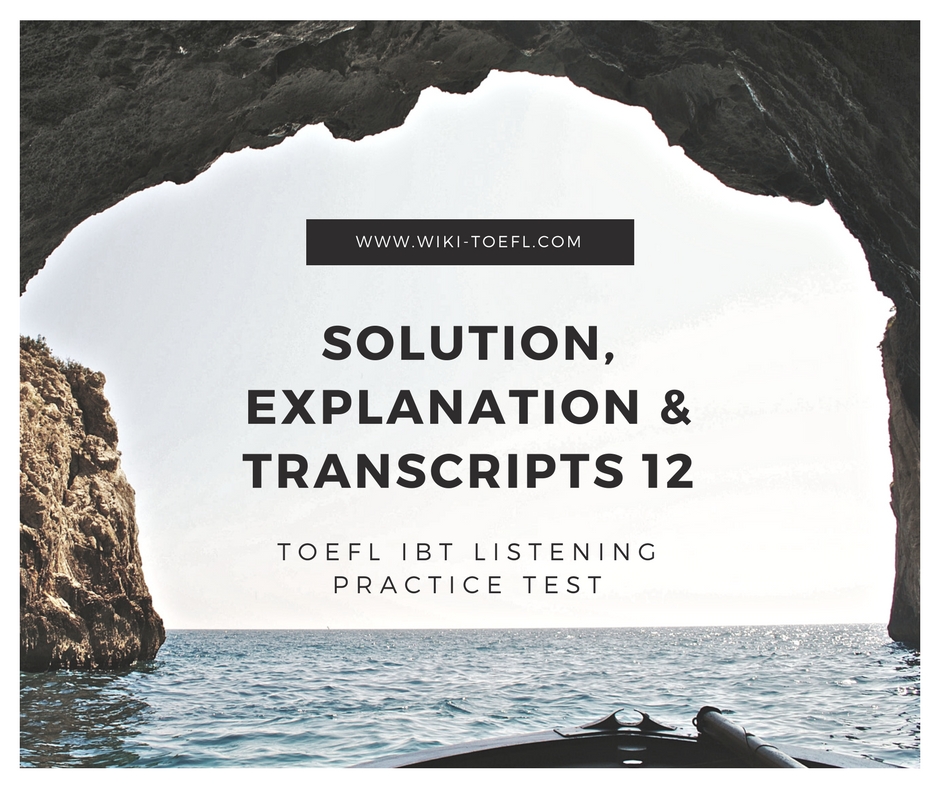Solution & Explanation for TOEFL iBT Reading Practice Test 26 from Delta’s Key to the Next Generation TOEFL Test – Six Practice Tests for the iBT by Nancy Gallagher

1. D The passage does not give the type of mineral as a factor in mass wasting. All of the other answers are given: …the angle of the slope is a major factor in the potential for mass wasting…; Water plays a significant role…; …absence of vegetation…. (1.2)
2. B The name of a mass wasting process is a reflection of the material that is moved and the way it moves. Clues: One way to classify mass wasting processes is on the basis of the material involved…rock, debris, earth, or mud. The manner in which the material moves is also important…a fall, a slide, or a flow. (1.1)
3. C Trigger means cause in this context. Clues: Rain or snowmelt can trigger a rockslide by wetting the underlying surface…can no longer hold the rock in place. The water from the rain or snowmelt causes a rockslide to occur. (1.4)
4. A A rock avalanche moves faster than other types of rockslides because the rock moves over a layer of compressed air. Clues: The fastest type of slide is a rock avalanche, in which a mass of rock literally floats on air as it moves downslope. The high speed of a rock avalanche is the result of air becoming trapped and compressed beneath the falling mass of debris…. (1.1)
5. A Buoyant means floating in this context. Clues: …a mass of rock literally floats on air as it moves downslope; …air becoming trapped and compressed beneath the falling mass of debris…. (1.4)
6. C Anchor means hold in this context. Clues: …rainstorms in semiarid regions…; When a rainstorm or rapidly melting snow creates a sudden flood, large quantities of soil and loose rock are washed into nearby stream channels because there is usually little or no vegetation to anchor the surface material. (1.4)
7. B The referent of that is something of wet concrete to which the consistency of the mudflow may be similar. Logic tells you that that refers to consistency. (1.3)
8. A The removal of native vegetation by brush fires… is paraphrased in Fire has destroyed much of the original vegetation…’, …has increased the probability of these destructive events is paraphrased in …so mudflows are now more likely. (1.7)
9. D You can infer that mudflows are so dangerous because people do not expect them to occur. Clues: …mudflows are a serious hazard to development on and near canyon hillsides;… because mudflows occur infrequently, homeowners are often unaware of the potential danger of building on the site of a previous mudflow. (1.5)
10. B You can infer that lahars occur in Indonesia. Clues: Mudflows containing volcanic debris are called lahars, a word originating in Indonesia, a region that experiences many volcanic eruptions. (1.5)
11. C The author’s purpose is to emphasize the fast speed of lahars. Clues: …altering the landscape in a relatively short period. One meaning of race is to move at a high speed. (1.6)
12. C In the added sentence, Thus is a transition that shows result. Thus links Rain or snowmelt can trigger a rockslide in the previous sentence with rockslides occur more frequently during the spring, when heavy rains and melting snow are most prevalent in the added sentence. (1.8)
13. A, D, G Rockslides: Rockslides occur when a coherent mass of rock breaks loose and slides down a slope as a unit; … where there are joints and fractures in the rock that are parallel to the slope; …a mass of rock literally floats on air as it moves downslope.
B, C, H, I Mudflows: Mudflows…involve soil and a large amount of water; The consistency of the mudflow may be similar to that of wet concrete, or it may be a soupy mixture…; When a mudflow is dense, it moves more slowly, but it can easily carry or push large boulders, trees, and even houses along with it; Mudflows containing volcanic debris are called lahars…; Lahars occur when highly unstable layers of ash and debris become saturated with water…. Answers (E) and (F) refer to neither rockslides nor mudflows. (1.10)
14. C The passage does not state that a strong labor union was a characteristic of the Triangle Waist Company’s factory. All of the other answers are given: …the inhumane working conditions…an unsanitary and dangerous work environment; Most of the workers were women…; The shirt factory occupied the top three floors…. (1.2)
15. D Already struggling with a new language and culture… is paraphrased in The workers experienced cultural difficulties…’, …these workers could not speak out about working conditions for fear of losing their desperately needed jobs… is paraphrased in …without complaint because they needed their jobs; …and this forced them to endure exploitation by the factory owners is paraphrased in .. .poor conditions, and exploitation…. (1.7)
16. B Ignited means caught fire in this context. Clues: …a rag bin…was on fire; …tried to extinguish the flames, but their efforts proved futile…;… the fire spread. (1.4)
17. A The author’s purpose is to emphasize the unsafe working conditions. Clues: The incident highlighted the inhumane working conditions faced by many industrial workers, including…an unsanitary and dangerous work environment; …they found it rotted and useless. (1.6)
18. C Many workers on the top floor managed to escape the fire on ladders. Clues: …the ten-story Asch Building; The seventy employees who worked on the tenth floor escaped the fire… by climbing onto the roof where students from New York University, located across the street, stretched ladders over to the Asch Building. (1.1)
19. C The referent of Still others is something or someone that climbed onto the fire escape. The previous three sentences discuss the efforts of the ninth-floor workers to escape the fire, and the pronouns their, they, some, and Others in these sentences refer to ninth-floor workers. Logic tells you that Still others also refers to ninth-floor workers. (1.3)
20. A Spindly means weak in this context. Clues: …inadequately constructed fire escape;…it bent under the weight of hundreds of workers…; …separated from the wall, falling to the ground…. (1.4)
21. C You can infer that the women on the window ledges did not escape. Clues: The young women trapped on the ninth floor waited on the window ledges to be rescued, only to discover that the ladder, fully raised, stopped far below them at the sixth floor; …killing 146 workers, mostly immigrant women. (1.5)
22. D The author argues that the cause of the disaster was the lack of fire safety measures. Clues: …the Triangle fire tragically illustrated that fire inspections and safety precautions were very inadequate. The victims of the fire were trapped by the lack of fire escapes…. (1.1)
23. B The statement that an era of progressive reform began to sweep the nation means that the idea of reform became widespread. Clues: The incident had a profound impact…affecting local and national politics in the process;.. .people decided that government had a responsibility…; …a public outcry for laws to regulate workplace safety. (1.4)
24. C You can infer that the author believes the Triangle fire increased awareness of workplace safety and led to necessary reform. Clues: The incident had a profound impact on…job safety…; An era of progressive reform began to sweep the nation…; There was a public outcry for laws to regulate workplace safety;…led to many new regulations in the years following the fire. (1.5)
25. C The added sentence further develops the idea that The incident had a profound impact on women s unionism and job safety, mentioned in the previous sentence. (1.8)
26. C, D, F Key information: Within minutes, the factory was consumed by flame, killing 146 workers, mostly immigrant women; The incident highlighted the inhumane working conditions faced by many industrial workers, including… dangerous work environment;
…the Triangle fire tragically illustrated that fire inspections and safety precautions were very inadequate; There was a public outcry for laws to regulate workplace safety;… their report led to many new regulations in the years following the fire. Answer (A) is a minor idea; answers (B) and (E) are not mentioned. (1.9)
27. B You can infer that music and poetry were part of Greek culture from very early times. Clues: Long before the ancient Greeks could read and write, they learned of their history and culture through epic poetry…; The bards chanted stories in standard musical phrases that were accompanied by musical instruments such as the lyre…. (1.5)
28. C Both Homer and Sappho were skilled lyre players. Clues: Homer, was a…master of the lyre; Another famous…lyre player was Sappho…. (1.1)
29. B The author’s purpose is to show that the period was a high point in Greek civilization. Clues: …during the fifth century BC, when politics, philosophy, art, architecture, and theater thrived, as they never had before. (1.6)
30. D Outgrowth means product in this context. Clues: Early drama…was an outgrowth of the choral songs and dances…; A chorus of singers, dancers, and musicians…performed stories that educated and entertained the audience…. The prefix out- = beyond. Drama was a new product that developed from choral songs and dances and grew beyond them. (1.4)
31. A The passage does not state that an emphasis on costumes and makeup characterized Greek drama. All of the other answers are given: The famous outdoor Theater of Dionysus in Athens showed the importance of drama to the Greeks; …a masked actor; …recited verses as a character in the story…spoken verses…; …the chorus sang the narrative passages. (1.2)
32. C The addition of an actor who spoke was a major development that changed choral performance into drama. Clues: The crucial innovation that turned choral performance into drama is attributed to Thespis…; Thespis would enter the theater as a masked actor; …he recited verses…and these spoken verses changed what had been a choral monologue into a dialogue between the actor and the chorus. (1.1)
33. B Legacy means contribution in this context. Clues: The crucial innovation that turned choral performance into drama is attributed to Thespis…; …the term “thespian,” which now describes anything relating to drama. The actor’s contribution to drama is honored by a word derived from his name. (1.4)
34. A The referent of which is something with a device like a speaking trumpet inside. Logic tells you that which refers to mask. (1.3)
35. A Still, despite the attention the actor received… is paraphrased in …even though the actor was also important; …the chorus and its music continued to dominate dramatic performances with the combined power of singing and dancing is paraphrased in The singers, dancers, and musicians remained at the center of drama…. (1.7)
36. D Adding a second and a third actor led to the actors becoming more important than the chorus. Clues: Now audience attention could be directed to the interplay between the two actors…; The addition of actors shifted the focus of drama away from the chorus toward the action and dialogue of the characters. (1.1)
37. C Adhered to means followed in this context. Clues: Playwrights continued to introduce innovations, but essentially they adhered to prescribed conventions. But shows contrast between the idea of introducing innovations (new developments) and adhering to prescribed conventions (established practices or rules). (1.4)
38. A The added sentence introduces the topic of standard forms and dramatic conventionsy which the rest of the paragraph develops with examples: One of these conventions…; The drama always took place…; Another convention…; … still another convention…. (1.8)
39. A, D, E Key information: …they learned of their history and culture through epic poetry chanted by bards or singers; Early drama was associated with the worship of the god Dionysus and was an outgrowth of the choral songs and dances performed in honor of the god; …enter the theater as a masked actor; …recited verses as a character in the story…; The addition of actors shifted the focus of drama away from the chorus toward the action and dialogue of the characters; …they adhered to prescribed conventions; Another convention reflected the society’s sense of balance and order…; The Greek concept of moderation is reflected in still another convention…. Answer (B) is not mentioned; answers (C) and F) are minor ideas. (1.9)











 nds from the western mountains to the eastern forest. All of the other answers are given: …temperatures can vary widely from very hot in summer to bitter cold in winter; The wetlands were soon surrounded by fluttering waves of grasses: shortgrass, mixed grass, and tall grass; An important feature of the northern Great Plains grasslands is the presence of millions of glacial depressions that are now small ponds known as prairie potholes. (1.2)
nds from the western mountains to the eastern forest. All of the other answers are given: …temperatures can vary widely from very hot in summer to bitter cold in winter; The wetlands were soon surrounded by fluttering waves of grasses: shortgrass, mixed grass, and tall grass; An important feature of the northern Great Plains grasslands is the presence of millions of glacial depressions that are now small ponds known as prairie potholes. (1.2)






